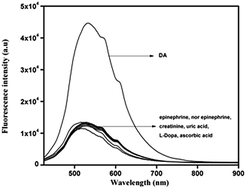Thioglycolic acid capped CdS quantum dots as a fluorescent probe for the nanomolar determination of dopamine
Abstract
Thioglycolic acid (TGA) capped CdS quantum dots (QDs) have been successfully employed as an efficient nano sized fluorescent probe for the selective determination of dopamine (DA) in acetate buffer solution (pH 7). The fluorescence emission spectrum of TGA functionalized CdS QDs which was at about 527 nm showed an enormous increase in emission intensity in the presence of DA. The linear range and detection limit of the developed turn on sensor were 3.94 × 10−7 to 4.67 × 10−8 M and 2.55 × 10−9 M, respectively. The addition of DA increases the passivation of surface traps of QDs thereby increasing the fluorescence emission intensity. The influence of some biologically important species that are structurally similar to DA on the fluorescence emission intensity of the CdS fluorescent probe was studied to evaluate the selectivity of the sensor. The developed turn on sensor exhibits good analytical figures of merit and excellent selectivity and shows promising practical applications.


 Please wait while we load your content...
Please wait while we load your content...